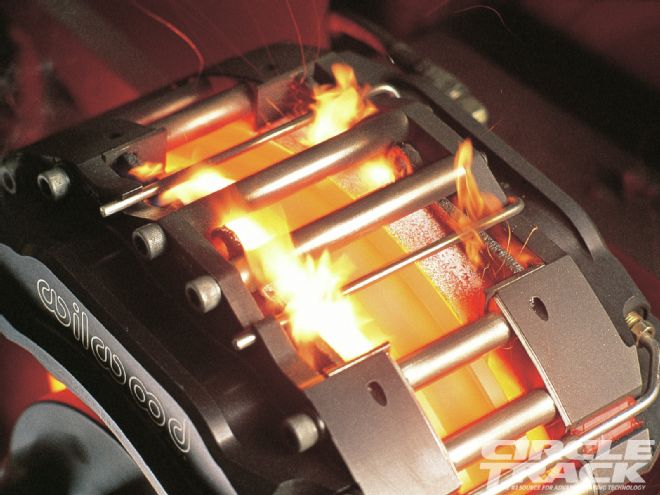
Going fast is important. I mean what would racing be without speed? But on the other side of the coin, going fast will end in dramatic fashion if you aren’t able to safely set your car for each corner and control deceleration. We all know this controlled decel comes from the braking system’s ability to slow the wheels down, but there is much more to the equation.
At its most basic operational level, the brakes are a hydraulic clamping system. In this system, fluid is pushed from the master cylinder using the brake pedal to the calipers, where pistons use this hydraulic pressure to squeeze the rotors with a set of brake pads. Sounds simple enough. And for the average enthusiast or racer, the rest of the details and engineering jargon aren’t always needed information. Brake manufacturers have done an amazing job of putting kits together, or having knowledgeable staffers to recommend parts for any given application, and all we need to do is assemble everything on our race cars.
01. Selecting the right components for your braking system is extremely important. Companies like Wilwood Engineering can help you assemble everything you need.">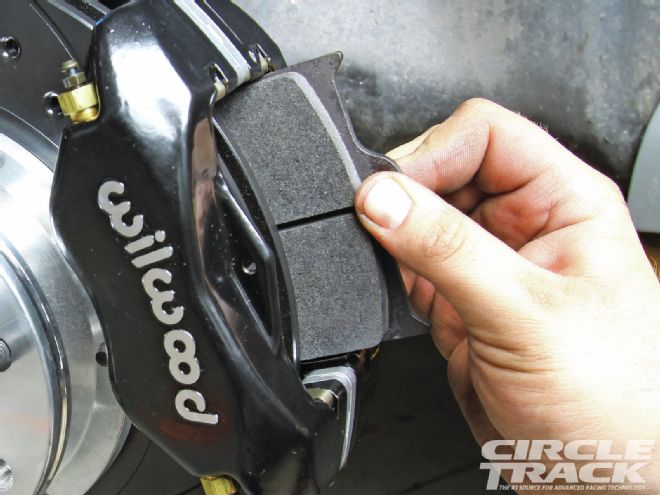 <strong> 01. </strong>Selecting the right components for your braking system is extremely important. Companies like Wilwood Engineering can help you assemble everything you need.
<strong> 01. </strong>Selecting the right components for your braking system is extremely important. Companies like Wilwood Engineering can help you assemble everything you need.
When it comes down to it, all of the pieces of the braking system need to be matched to what the intended use is. In many cases, a call to a company like Wilwood Engineering will net you all of the information you’ll need to assemble a brake system perfectly suited to your race car. In the grand scheme of race car parts, you most likely won’t have an excessive amount of options when it comes to the hard parts of the braking system. But brakes pads, on the other hand, give you many choices, which may vary depending on needs and driver preference.
Friction and Heat
The friction material used in brake pads is science—plain and simple. Different combinations and amounts of materials give you different levels of friction, which is an easy way to fine-tune a braking system. Friction creates heat. And although heat is normally not a good thing, in braking systems, it makes it all work—as long as it’s controlled. With any brake pad, there is an ideal operating temperature. Use it with too little heat and the pad will not work as well as it should, causing premature wear. Too much heat, and the metals and resins in the pad will melt and crystalize, causing a glazed condition, which reduces braking abilities. The compounds used in the friction materials dictate the characteristics, as well as the operating limits of different pads.
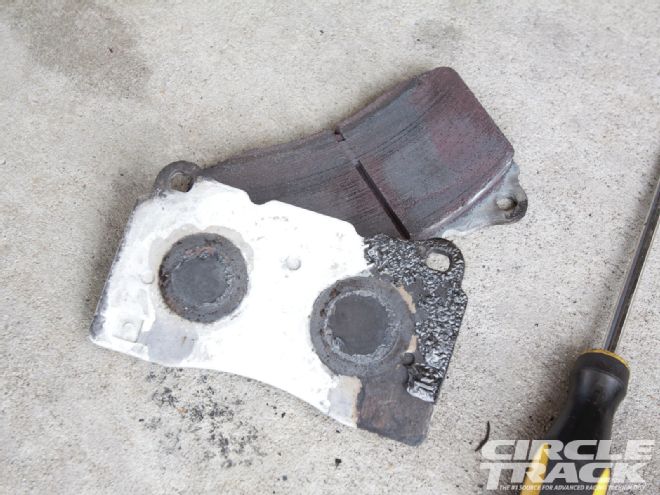 <strong> 05. </strong>Controlling the amount of heat in your braking system is extremely important. These pads were overheated, and you can see the melted paint on the backing plate. If you look at the pad surface, the resins and metals have liquefied on the surface. This crystallization is called glazing, and will greatly degrade brake performance.
<strong> 05. </strong>Controlling the amount of heat in your braking system is extremely important. These pads were overheated, and you can see the melted paint on the backing plate. If you look at the pad surface, the resins and metals have liquefied on the surface. This crystallization is called glazing, and will greatly degrade brake performance.
There can be as many as 60 different components that make up a brake pad compound. Many of these ingredients are activated when heated. The blends of these ingredients make up each compound’s characteristics. Initial bite or torque, and temperature range are some of the more common characteristics that drivers consider when picking a pad compound. Companies like Hawk Performance and Wilwood Engineering make a wide array of pads with different compounds for different racing situations.
In many situations, pad selection comes down to driver preference. With such a vast selection of pads, the choice can come down to which one suits a driver’s style, as much as the application. For instance, Hawk Performance’s highest level racing pad, the DTC-70, operates in a heat range of 400 degrees F to 1,600 degrees F, with a very high level of initial bite. If the heat range is what you need, but they brakes are too grabby, the DTC-60 offers the same heat range with less initial grab. Running a split between the front and rear is another great way to fine-tune your car’s braking ability and keep the car balanced on decel.
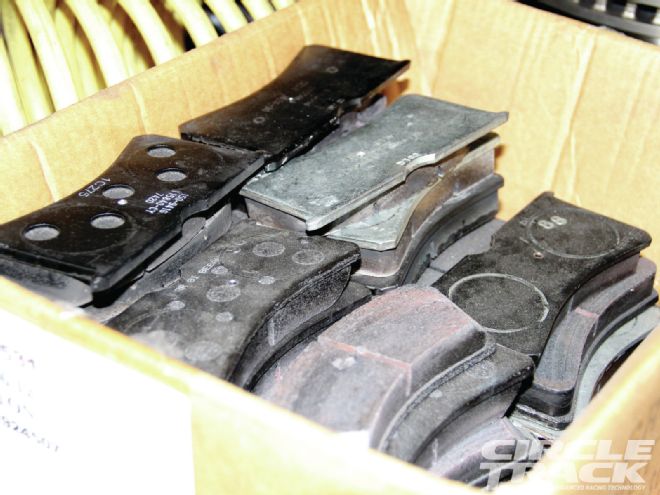 <strong> 06. </strong>Wilwood Engineering gave a us a look into its brake pad testing facility.
<strong> 06. </strong>Wilwood Engineering gave a us a look into its brake pad testing facility.
Brake pads are not a one-size-fits-all part. In asphalt racing, it’s not uncommon for brakes to cross the 1,000-degree threshold. But your average dirt car may only see around 500 degrees. Such extreme heat cycles on a constant basis makes it exceedingly important to use the right pad compound. With this much heat, it is also important to regularly check brake fluid. When the brakes reach upwards of 1,000 degrees, any moisture in the system (brake fluid will absorb any moisture it comes in contact with) will boil and turn to steam. This will degrade performance, as it will compress and less pressure will reach the calipers.
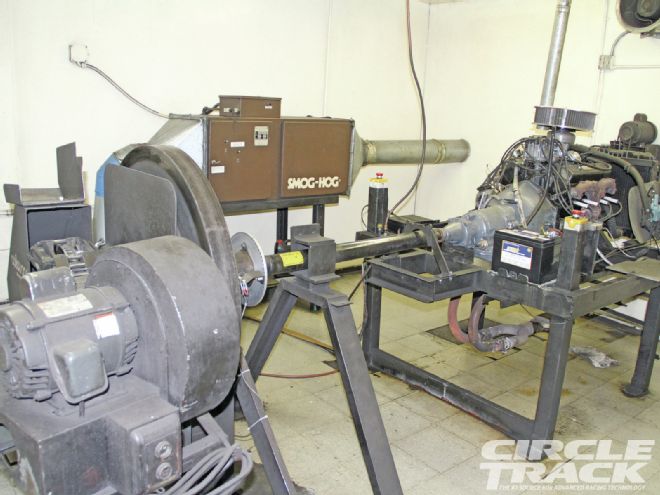 <strong> 07.0</strong>In the height of Wilwood’s involvement in NASCAR, it began pre-bedding pad and rotor combinations for teams. To accomplish this, they built a brake dyno with a 350ci Chevy engine and a fixture to mount a rotor and caliper. When the company decided to dial its racing program back, the dyno then became a useful piece of testing equipment.
<strong> 07.0</strong>In the height of Wilwood’s involvement in NASCAR, it began pre-bedding pad and rotor combinations for teams. To accomplish this, they built a brake dyno with a 350ci Chevy engine and a fixture to mount a rotor and caliper. When the company decided to dial its racing program back, the dyno then became a useful piece of testing equipment.
Pad Construction
Pad construction has come a long way, and there are three basic types of brake pads—organic, Ferro-carbon, and sintered metallic pads. Organic pads were formally manufactured using asbestos as the friction material, due to its ability to dissipate heat efficiently. When the dangers of asbestos dust became apparent, companies switched to different friction materials such as glass and rubber, resins that are able to withstand high heat, and Kevlar. These types of brake pads are still used in commercial truck applications where large amounts of weight are consistently on the brakes.
Ferro-carbon pads, like most race pads, are constructed with a mixture of different metals and resins. The Ferro-carbon pads come in many different compounds for different applications from street to full-race designs. The different compounds offer drivers different heat ranges and initial bite levels, which allow you to fine-tune corner entry based on the driver’s brake inputs.
Sintered metallic pads are used when grip is extremely important. Sintered metallic pads are used on airplanes, motorcycles, and in military applications. Although these pads offer a very high level of grip, they do wear much faster than organic or Ferro-carbon pads.
07.5 In the height of Wilwood’s involvement in NASCAR, it began pre-bedding pad and rotor combinations for teams. To accomplish this, they built a brake dyno with a 350ci Chevy engine and a fixture to mount a rotor and caliper. When the company decided to dial its racing program back, the dyno then became a useful piece of testing equipment.">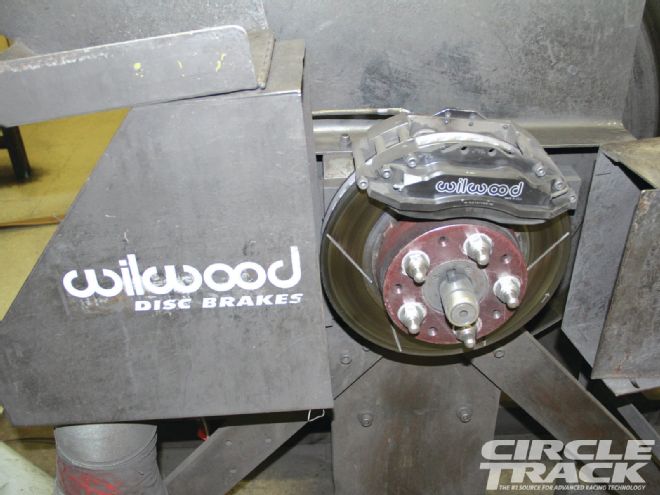 <strong> 07.5 </strong>In the height of Wilwood’s involvement in NASCAR, it began pre-bedding pad and rotor combinations for teams. To accomplish this, they built a brake dyno with a 350ci Chevy engine and a fixture to mount a rotor and caliper. When the company decided to dial its racing program back, the dyno then became a useful piece of testing equipment.
<strong> 07.5 </strong>In the height of Wilwood’s involvement in NASCAR, it began pre-bedding pad and rotor combinations for teams. To accomplish this, they built a brake dyno with a 350ci Chevy engine and a fixture to mount a rotor and caliper. When the company decided to dial its racing program back, the dyno then became a useful piece of testing equipment.
Stopping Power
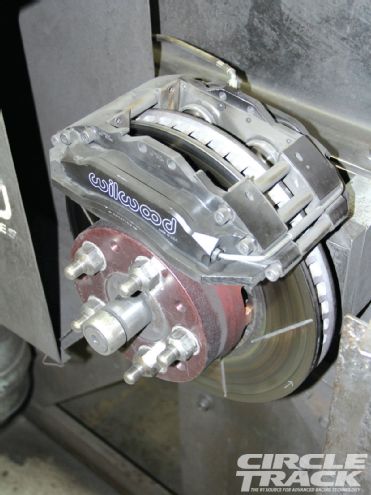 <strong> 08. </strong>
<strong> 08. </strong>
Something to keep in mind when talking about brake pads and braking capabilities is tires. In actuality, the brakes don’t slow the car, the tires do. The braking system slows the rotation of the wheels, and the tires’ traction on the ground reduces the momentum of the vehicle. The limit of traction can be greater or less than the braking system’s abilities, and sometimes what may be a traction issue can be misdiagnosed as a braking issue.
Bedding Your Pads
You may be wondering what bedding in the pads means and why it’s important. The concept is pretty simple. You make a series of aggressive stops with new rotors and pads to bring them up to temperature for the first time. In the process, you are transferring a thin layer of pad material to the surface of the rotor. This allows the pads and rotors to last longer, but it also improves braking abilities as the pads get a better grip on a rotor when it has this layer of material on it.
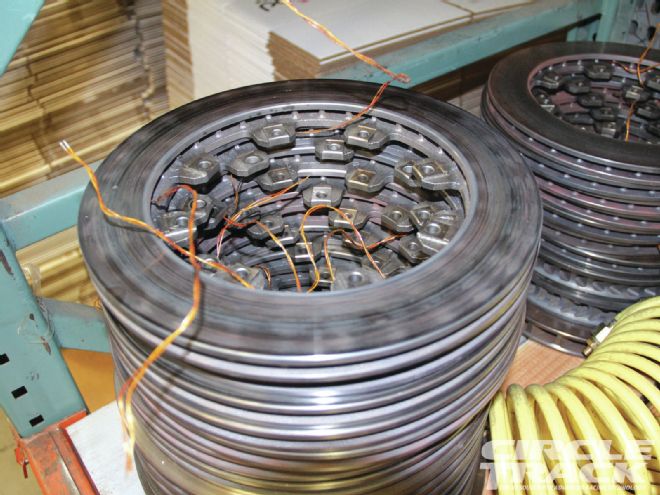 <strong> 10.5 </strong>Pads and rotors used for testing are outfitted with sensors to accurately measure temperature. This allows the company to determine how much heat the pads and rotors can safely handle.
<strong> 10.5 </strong>Pads and rotors used for testing are outfitted with sensors to accurately measure temperature. This allows the company to determine how much heat the pads and rotors can safely handle.
At the height of its involvement in NASCAR, Wilwood began offering pre-bedded pad and rotor combination to race teams. This freed up practice time because teams didn’t have to waste a session just for bedding brakes. Wilwood still offers this for select rotor and pad combinations.
When it comes to bedding brakes, the process is similar, but most manufacturers have different requirements. Check with your specific brake pad manufacturer for specific bedding instruction.
Coming to a Stop
The perfect braking system comes down to having the correct parts. The combination of the right calipers with the correct piston sizes, the right rotors made from the right material, the right pads, and the right fluid pushed through a properly sized master cylinder needs to be inline for everything to work as intended. If any one of these pieces is off by too much, your braking capabilities will be compromised. Whatever you run for brakes, wide-5 to stock binders, to Wilwood’s six-piston race brakes, having the right combination will make or break your ability to stop.